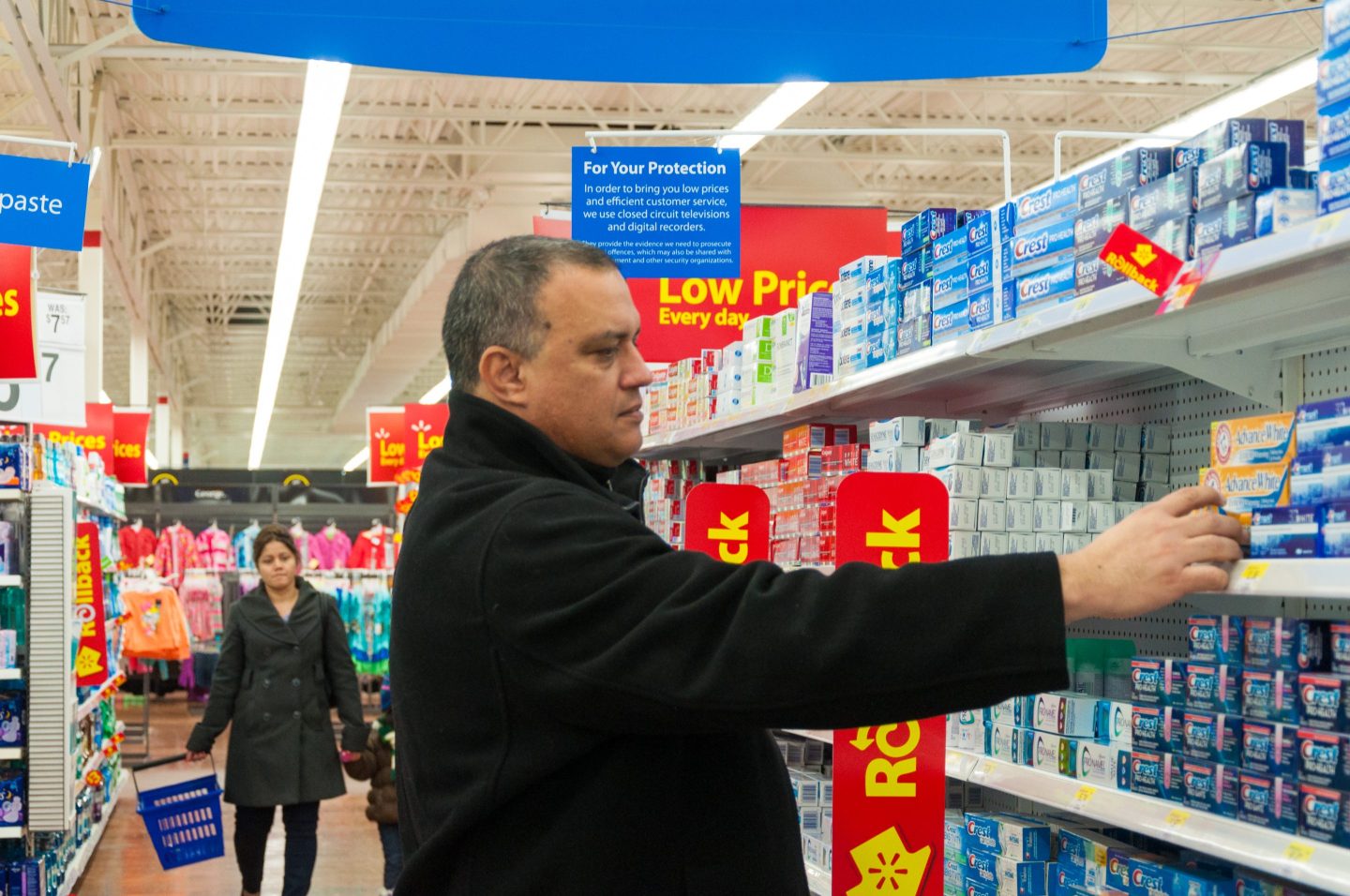受通货膨胀影响,美国人消费降级

美国人正在削减个人卫生用品支出,这暴露出美国经济和消费品企业面临的困境。
虽然通胀大幅上升,得益于收入增长和政府刺激措施,消费者并没有停止消费。但这些好处正在消失,而且美国人目前正在节省开支,甚至减少厕纸和牙膏等日用品消费。7月12日发布的6月消费物价指数,让我们对美国的经济环境有更深入的了解。消费物价指数显示年度通胀率下降至3%,这是自2021年3月以来的最低水平。
晨星(Morningstar)的分析师艾琳·拉希说:“过去几个月,消费者面临的压力增加。”她表示,食品援助项目减少、退税额降低、额外储蓄和刺激资金耗光,均对消费者产生了影响。
以伊利诺伊州奥克帕克抚养两个女儿的单亲妈妈霍莉·厄恩斯特为例。48岁的厄恩斯特依旧要面对日益增长的成本,包括两居室公寓的租金即将上涨等,她最近开始停止购买脱毛膏,而是用肥皂代替,而且牙膏也从宝洁公司(Procter & Gamble Co.)的佳洁士(Crest)改为价格更低的高露洁(Colgate)。她也不再购买艾维诺(Aveeno)护肤液,而是用联合利华(Unilever Plc)的品牌凡士林(Vaseline)为家人保湿。
厄恩斯特是一家律师事务所的活动协调员。她表示:“现金的购买力大不如前。”虽然削减了开支,但她依旧不得不使用信用卡维持生计。“我接受了现实。”
5月的消费者支出报告显示,所有商品和服务的通胀调整后家庭支出自今年早些时候大幅上涨以后,基本已经陷入停滞。
跟踪美国零售商销售额的NIQ发现,个人卫生产品,包括必需品,均受到了影响。截至6月24日的52个周,牙膏、洗涤剂和厕纸的销量下降了约3%至4%。随着美国人恢复工作和旅行,美国家庭对一些产品的使用量确实在减少。
这意味着消费品公司和零售商在今年余下的时间里将面临艰难的处境。这些公司将在未来几周公布最新季度业绩。它们的股票今年拖累了标准普尔500指数(S&P 500),而且它们似乎也不再有能力继续涨价和粉饰损益表。
过去四个季度,宝洁的出货量持续下降。竞争对手金佰利公司(Kimberly-Clark Corp.)也是同样的状况。今年早些时候,该公司称,随着消费者选择更便宜的超市品牌,预计2023年物价上涨幅度会有所下降。
NIQ的卡曼·阿利森说:“你需要寻找新途径发展业务,而不是继续靠涨价,因为消费者已经变得捉襟见肘。更多的人正在依靠工资维持生计。”
与此同时,有更多的迹象显示消费者经济面临压力,随着超额储蓄减少,购物者越来越依赖信用卡。借款拖欠率也在升高。
咨询公司Prophet的首席转型官和高级合伙人迈克·莱泽尔指出:“人们的想法是:‘我要减少购物,因为商品价格变得过于昂贵。’”
当面临经济困境时,在零售业,消费者通常会选择价格更低廉的店铺降级消费,这似乎就是第二季度的状况。
塔吉特(Target Corp.)降低了超市和专业连锁店的价格,但分析信用卡和借记卡数据的Bloomberg Second Measure公司显示,其交易额从4月到6月同比依旧下降了7.2%。这是自新冠疫情以来,该零售商到目前为止销售额降幅最大的一个季度。与此同时,沃尔玛(Walmart Inc.)和Dollar General公司(Dollar General Corp.)的交易额分别增长了3.7%和6%。
莱泽尔说:“我们目前的处境非常不安定。无论消费者的健康还是经济健康,都摇摇欲坠。”(财富中文网)
——里德·皮克特(Reade Pickert)对本文亦有贡献。
译者:刘进龙
审校:汪皓
美国人正在削减个人卫生用品支出,这暴露出美国经济和消费品企业面临的困境。
虽然通胀大幅上升,得益于收入增长和政府刺激措施,消费者并没有停止消费。但这些好处正在消失,而且美国人目前正在节省开支,甚至减少厕纸和牙膏等日用品消费。7月12日发布的6月消费物价指数,让我们对美国的经济环境有更深入的了解。消费物价指数显示年度通胀率下降至3%,这是自2021年3月以来的最低水平。
晨星(Morningstar)的分析师艾琳·拉希说:“过去几个月,消费者面临的压力增加。”她表示,食品援助项目减少、退税额降低、额外储蓄和刺激资金耗光,均对消费者产生了影响。
以伊利诺伊州奥克帕克抚养两个女儿的单亲妈妈霍莉·厄恩斯特为例。48岁的厄恩斯特依旧要面对日益增长的成本,包括两居室公寓的租金即将上涨等,她最近开始停止购买脱毛膏,而是用肥皂代替,而且牙膏也从宝洁公司(Procter & Gamble Co.)的佳洁士(Crest)改为价格更低的高露洁(Colgate)。她也不再购买艾维诺(Aveeno)护肤液,而是用联合利华(Unilever Plc)的品牌凡士林(Vaseline)为家人保湿。
厄恩斯特是一家律师事务所的活动协调员。她表示:“现金的购买力大不如前。”虽然削减了开支,但她依旧不得不使用信用卡维持生计。“我接受了现实。”
5月的消费者支出报告显示,所有商品和服务的通胀调整后家庭支出自今年早些时候大幅上涨以后,基本已经陷入停滞。
跟踪美国零售商销售额的NIQ发现,个人卫生产品,包括必需品,均受到了影响。截至6月24日的52个周,牙膏、洗涤剂和厕纸的销量下降了约3%至4%。随着美国人恢复工作和旅行,美国家庭对一些产品的使用量确实在减少。
这意味着消费品公司和零售商在今年余下的时间里将面临艰难的处境。这些公司将在未来几周公布最新季度业绩。它们的股票今年拖累了标准普尔500指数(S&P 500),而且它们似乎也不再有能力继续涨价和粉饰损益表。
过去四个季度,宝洁的出货量持续下降。竞争对手金佰利公司(Kimberly-Clark Corp.)也是同样的状况。今年早些时候,该公司称,随着消费者选择更便宜的超市品牌,预计2023年物价上涨幅度会有所下降。
NIQ的卡曼·阿利森说:“你需要寻找新途径发展业务,而不是继续靠涨价,因为消费者已经变得捉襟见肘。更多的人正在依靠工资维持生计。”
与此同时,有更多的迹象显示消费者经济面临压力,随着超额储蓄减少,购物者越来越依赖信用卡。借款拖欠率也在升高。
咨询公司Prophet的首席转型官和高级合伙人迈克·莱泽尔指出:“人们的想法是:‘我要减少购物,因为商品价格变得过于昂贵。’”
当面临经济困境时,在零售业,消费者通常会选择价格更低廉的店铺降级消费,这似乎就是第二季度的状况。
塔吉特(Target Corp.)降低了超市和专业连锁店的价格,但分析信用卡和借记卡数据的Bloomberg Second Measure公司显示,其交易额从4月到6月同比依旧下降了7.2%。这是自新冠疫情以来,该零售商到目前为止销售额降幅最大的一个季度。与此同时,沃尔玛(Walmart Inc.)和Dollar General公司(Dollar General Corp.)的交易额分别增长了3.7%和6%。
莱泽尔说:“我们目前的处境非常不安定。无论消费者的健康还是经济健康,都摇摇欲坠。”(财富中文网)
——里德·皮克特(Reade Pickert)对本文亦有贡献。
译者:刘进龙
审校:汪皓
Americans are cutting back on personal hygiene products in a troubling sign for the US economy and consumer-focused companies.
Despite surging inflation, shoppers kept spending thanks to income gains and government stimulus. But those benefits are waning, and now Americans are skimping, even on everyday items such as toilet paper and toothpaste. More insights on the economic environment come on July 12 with the release June’s consumer price index. That measure shows annual inflation slowed to 3%, its lowest level since March 2021.
“The strains that the consumer is under have been exacerbated over the last couple of months,” said Morningstar analyst Erin Lash. The reduction of food assistance programs, lower tax returns and using up extra savings and stimulus funds have an impact, she said.
Take Hollie Ernst, a single mother of two daughters from Oak Park, Illinois. Still facing rising costs, including a looming rent increase on her two-bedroom apartment, the 48-year-old recently stopped buying shaving cream — soap will have to do — and traded down to cheaper Colgate toothpaste from Crest, made by Procter & Gamble Co. She also cut out Aveeno lotion, so now her family moisturizes with Vaseline, a Unilever Plc brand.
“Cash doesn’t stretch as far as it used to,” said Ernst, who is an event coordinator at a law firm. Even with her spending cuts, she still had to use a credit card to make ends meet. “I just accepted that’s the way it is.”
May’s consumer spending report showed that inflation-adjusted household outlays for all goods and services have essentially stalled after a surge early this year.
Personal-hygiene products, including staples, have taken a hit, according to NIQ, which tracks purchases at US retailers. Units sold of toothpaste, laundry detergent and toilet paper are down around 3%-4% in the 52 weeks through June 24. To be sure, some products are being used less at home as Americans return to work and travel.
This sets up a tough remainder of the year for consumer-goods companies and retailers, which begin reporting their latest quarterly results in a few weeks. Their stocks have trailed the S&P 500 this year, and now their ability to keep raising prices and gloss up their income statements looks like it won’t work much longer.
At Procter & Gamble, shipment volumes have declined for the past four quarters. Same goes for rival Kimberly-Clark Corp., which said earlier this year that it expects price increases to subside in 2023 as consumers shift to less-expensive store brands.
“You need to find a new way to grow your business other than price because consumers are getting tapped out,” said NIQ’s Carman Allison. “More people are living paycheck to paycheck.”
Meanwhile, there are more signs of stress in the consumer economy, with shoppers relying more on credit cards as excess savings dwindle. Delinquency rates are on the rise, too.
“People are just saying, ‘I’m going to buy less because it’s gotten too expensive,’” said Mike Leiser, chief transformation officer and senior partner at consultant Prophet.
In retail, consumers often trade down to cheaper stores during tough economic times, and that looks like it played out in the second quarter.
Target Corp. undercuts department stores and specialty chains on price, but its transactions still sank 7.2% from April to June, compared to the same period a year ago, according to Bloomberg Second Measure, which analyzes credit and debit card data. That’s by far the retailer’s biggest quarterly decline of the pandemic. Meanwhile, purchases at Walmart Inc. and Dollar General Corp. rose 3.7% and 6%, respectively.
“We’re in a very precarious position,” Leiser said. “Not only the health of the consumer, but the health of the economy.”
–With assistance from Reade Pickert.













